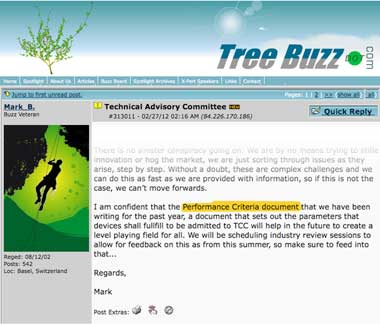A number of high profile, international, height safety manufacturers have visited Treetools, in Auckland, over the last week.
The common thread in our discussions has been product certification, gear compatibility, configuration issues and fit-for-purpose applications when it comes to tree climbing equipment.
If you stop and listen to these qualified guys you begin to appreciate the problems faced by the ITCC Technical Advisory Committee in deciding which pieces of equipment are suitable for tree climbing competitions… and those which are not.
For one thing, the TAC does not test any gear.
This means the committee does not have the luxury, afforded to most PPE manufacturers, of finding the weak points in individual components.
And the Technical Advisory Committee certainly does not have the capacity to test all the different configurations likely to be applied by international tree climbers.
As we all know, once you start configuring these individual tree climbing components the safety issues have the potential to magnify tenfold.
In reality, it appears the tree climbing gear configuration problem is so big, even well respected PPE manufacturers have (pretty much) abandoned configuration testing altogether apart from like-for-like applications with their own equipment.
So… to keep things manageable, TAC members currently rely solely on manufacturer information to make their decisions (and that makes some sense).
Over this last week Treetools has discovered that even prominent manufacturers, like Petzl, sometimes struggle with the gear configurations adopted by tree climbers.
In many instances, fully certified individual components, simply do not work together. Yet, in other instances, the same components are fit-for-purpose.
The term 'fit-for-purpose' is important here.
A fit-for-purpose product could, in some cases, supersede current manufacturing certification for that product, not unlike LOLER inspections do in the UK.
For example, non-CE rated harnesses cannot be sold by retailers in the UK but imported product could be deemed fit-for-purpose by a LOLER inspector (or, at least, that is Treetools understanding of the situation).
This means 'un-certified' products may be accepted by the ITCC if they reach the certain fit-for-purpose or performance criteria.
According to TAC chair, Mark Bridge, the ITCC is working towards a Performance Criteria 'document' to help define what fit-for-purpose (in competent hands) actually means.
You'll find a reference to the TAC Performance Criteria document in a recent Tree Buzz post. Mark's reference is right at the bottom of the post - see below.
Treetools believes the TAC Performance Criteria will establish a list of manufacturer requirements for submitting gear to the ITCC for approval. The gear will have to 'tick the boxes' so to speak.
This is a major step forward for tree climbing innovation in our opinion.
If planned correctly the Performance Criteria should, in theory, provide a level playing field for tree climbing innovators to present their ideas to the ITCC, without all the fuss we are currently witnessing with the Singing Tree Rope Wrench.
The first public viewing of the TAC Performance Criteria document is scheduled for the northern hemisphere summer.
The 2012 ETCC is the likely launch pad but we should certainly see something before the international tree climbing competition in Portland.
Watch this space!

